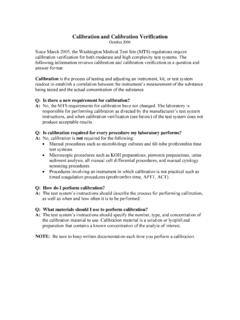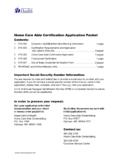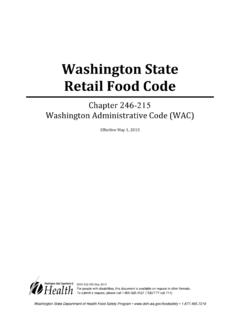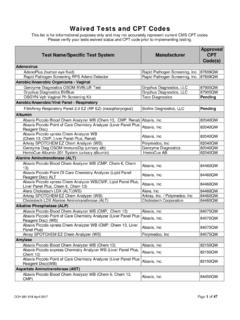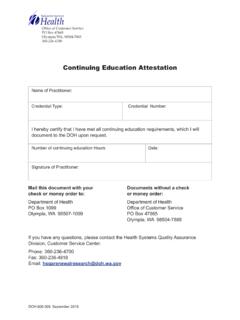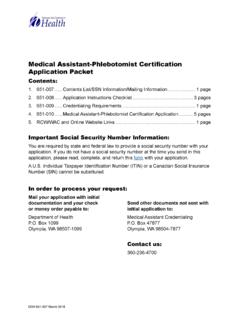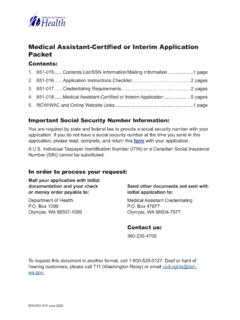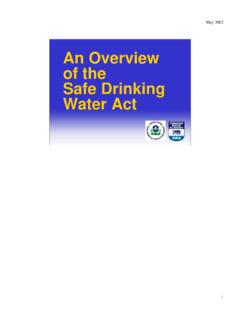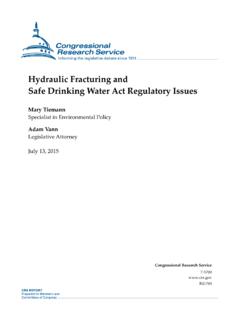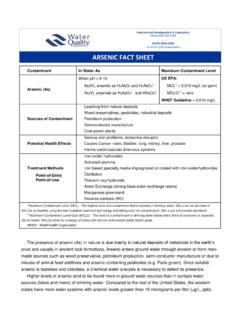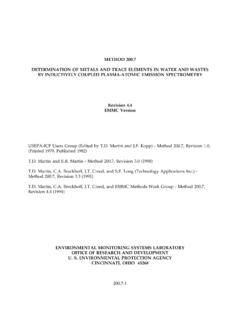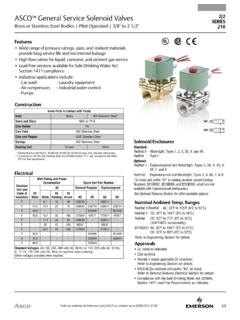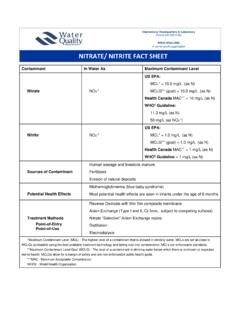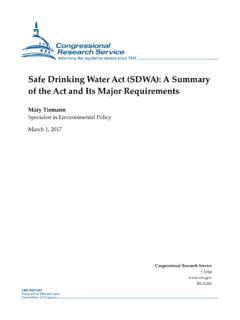Transcription of Owning and Managing a Group A Water System
1 Owning and Managing a Group A Water System A critical responsibility There is nothing more important to sustaining life than Water specifically, safe and reliable Water to drink. If you are new to public Water System ownership, this guide will give you a brief overview of your responsibilities and some tips to help you make decisions that will sustain the long-term capacity of the System . For experienced board members and officials, this guide is a good refresher. As a Group A Water System owner, officer, or employee, your decisions affect the quality of life for the customers who receive Water and pay their bill, and the community its businesses, industries, schools, churches and other public places. Communities thrive because of their Water supply. Providing safe drinking Water is not as easy as it may seem. That clear glass of tap Water you drink today is not the product of luck.
2 It takes hard work by those at the Water System that provides it, those who set drinking Water quality standards, and those who help the Water System meet those standards. Owning and Managing a Group A Water System can be rewarding. By meeting your legal responsibilities, you can protect your customers from illness or even death from waterborne disease. Doing so will also help you avoid fines, lawsuits, and extra work. Legal obligations The and Washington State have a legal framework for providing safe drinking Water . As a Water System official, you must know about the rules to follow as well as how those rules, standards and practices may change in the future. Because of the complex nature of the regulations, it can be difficult to know exactly how and when you may be liable for Water System activities. Understanding the legal framework is a big step toward being successful.
3 Congress passed the safe drinking Water Act ( sdwa ) in 1974 to protect public health by regulating the nation's public drinking Water supply. Under the sdwa , the Environmental Protection Agency (EPA) sets standards for drinking Water quality and oversees the states, localities, and Water suppliers who implement those standards. December 2013 DOH 331-084 Revised Group A Water systems have 15 or more service connections or serve 25 or more people 60 or more days per year. -2- EPA granted the Washington State Department of Health Office of drinking Water the authority to implement the safe drinking Water Act and enforce federal drinking Water rules in our state. The state rules we use to govern Group A public Water systems are in the Washington Administrative Code (WAC chapter 246-290 and chapter 246-292). These rules cover many areas of Water System operations and management, and are consistent with the sdwa .
4 For a brief history of drinking Water regulation, see Page 7 of this publication. Regulations and regulators that may apply to your Water System While this is not a complete list, it will give you a good foundation. Agency Topic Regulation or Source Environmental Protection Agency safe drinking Water Act See EPA Website WA Dept. of Health* Group A public Water supplies Chapter 246-290 WAC WA Dept. of Health Water works operator certification Chapter 246-292 WAC WA Dept. of Health Water System Coordination Act Chapter 246-293 WAC WA Dept. of Health drinking Water operating permits Chapter 246-294 WAC WA Dept. of Health Satellite System management agencies Chapter 246-295 WAC WA Dept. of Health drinking Water State Revolving Fund Loan Program Chapter 246-296 WAC WA Dept. of Ecology Water rights See Ecology Website WA Utilities & Transportation Commission (UTC) Rate approval for some private for-profit Water systems See UTC Website * Local health departments may carry out some activities for us.
5 Key requirements and responsibilities Collect Water quality samples from the Water source and distribution System and factually report the results to local and state health departments. If you have questions about your Water System requirements, contact our nearest regional office. When Water quality does not meet requirements, notify all your customers using our approved language and timeframes. For details, see Public notification helps to protect public health (331-239). Provide an adequate quantity of Water , delivered under proper pressure, at all times. Employ a certified waterworks operator, under most circumstances. Properly operate, maintain, and protect your Water System from vandalism, damage, and contamination. Develop and practice an emergency response plan. Keep your Water Facilities Inventory current and alert us right away, if there are changes in ownership, management, or operations of your Water System .
6 Promptly follow-up on all items identified during a sanitary survey of your Water System . -3- Put important operating policies in writing. For details, see Service Area Policies (331-438). Include all costs in your annual budgeting process, including capital improvements, preventive maintenance, and Water quality sampling. Maintain communication with customers. Participate in drinking Water -related training and take advantage of one-on-one on-site technical assistance opportunities. Running the Water System like a business The bottom line for most businesses is profitability: How much money did we gain or lose? Although some public Water systems in Washington are private for-profit businesses, most are public entities owned by cities, Water districts and irrigation districts, or privately owned nonprofit entities, such as homeowners associations. The bottom line for public Water systems is whether they can provide safe and reliable Water now and in the future.
7 Financial health is certainly very important for Water systems to achieve sustainable safe and reliable Water , but good public health outcomes should be the System s ultimate goal. No matter how the utility s governing body is organized, the customers benefit when the Water System operates in a purposeful, business-like manner. Businesses succeed when they have a well thought out business plan to drive their actions. The same is true for Water systems. A planning document, and the process of preparing it, allows Water systems to decide what they need to do, how they are going to do it, and how they are going to finance their current and future operations. Liability exposure In a Water System , the officers or the board of directors are the principals in charge. System employees act at the direction of the principal; and, the principals are responsible for the actions of their employees as long as the employees operate within their scope of authority.
8 The direction you provide employees may be explicit or implied. Ordinances, by-laws, personnel regulations, job descriptions, collective bargaining agreements, contracts with employees or outside laboratories, organizational charts, memoranda, and bulletins or advisory guidelines establish the scope of authority for principles and employees. Potential consequences of violating requirements Required action or costly fines. We take many steps to ensure you know the requirements to run a Water System . If a Water System fails to meet the requirements of a regulation, the EPA or our office may require specific remedies or impose daily fines for each violation. Red operating permit. The operating permit is a way to evaluate a System s compliance with drinking Water requirements. A red operating permit indicates the Water System is inadequate and in substantial noncompliance with the requirements.
9 This could result in the denial of building permits, on-site sewage disposal permits, food service permits, liquor licenses, and other permits or licenses for properties that are, or will be, connected to the Water System . In addition, lending institutions may choose not to finance loans for buying, refinancing, or remodeling if they are -4- associated with these properties. For more information, see Operating permits for drinking Water systems (331-168). Lawsuits. Regulatory agencies or Water System customers may take legal action to force a System to comply. The sdwa allows citizens to sue a System for exceeding maximum contaminant levels. Restaurants, childcare or health care facilities, and other Water customers may also take action against the System . These cases might have standing in court if there s an argument that the Water users suffered injury the general public did not.
10 Before you start Before you buy, develop, or decide to manage your own Water System , ask two questions: 1. Is Water available from a nearby utility? If so, you may be required to receive Water service from that utility. 2. Is there a Satellite Management Agency (SMA) operating in your area? If yours is a new Water System , you may be required to contract for management services with the SMA. If yours is an existing System , contracting with an SMA may be less costly and more efficient than going it on your own. If you answer Yes to either question, you may not need to take on the responsibilities of Managing a Water System . Getting started: Capacity development and planning Capacity development framework. Systems that develop and maintain sound technical facilities, good financial condition and controls, and proper management are most likely to provide safe drinking Water now and in the future.

